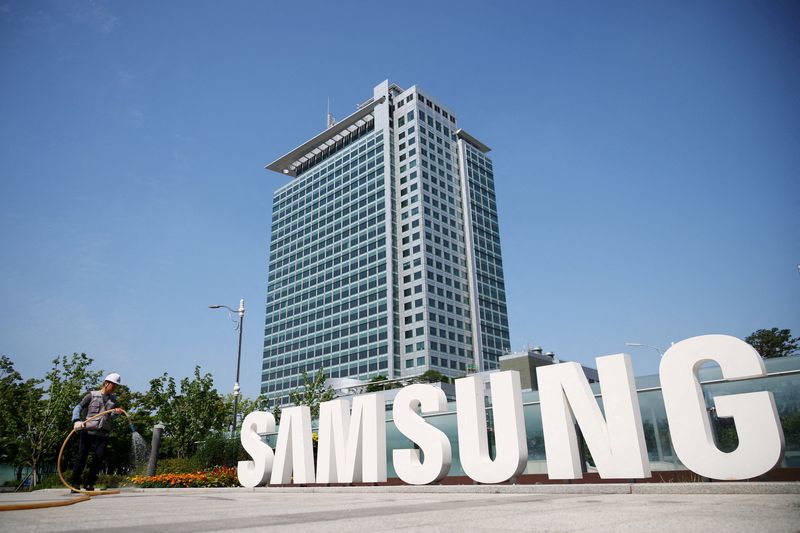By Joyce Lee and Heekyong Yang
SEOUL (Reuters) -Samsung Electronics on Tuesday said it will continue to cut production to ease a chip supply glut, and gear up for 2024 when it expects industry-wide investment and production to focus on high-end chips for generative artificial intelligence.
Samsung (KS:005930) has slashed chip output this year to weather an unprecedented industry downturn, and flagged further production adjustment, especially for NAND flash memory chips, as the market starts to recover.
"We've received purchase inquiries from (server) customers seeking to secure components ... based upon widening awareness that the industry has reached bottom," Jaejune Kim, memory business executive vice president, said on an earnings call.
"Considering the normalisation of inventory levels, we expect market recovery to accelerate in PC and mobile memory."
The proliferation of on-device AI functions will increase appetite for DRAM chips such as high bandwidth memory (HBM) in 2024, the world's biggest memory chip and smartphone maker said.
Samsung competes in memory chips for AI with the likes of SK Hynix, which took the lead in HBM3 chips by supplying tech major Nvidia (NASDAQ:NVDA). Chipmakers are now developing the next generation HBM3E for 2024.
Samsung said it plans to increase HBM output capacity by 2.5 times or more in 2024 versus this year.
Shares in Samsung were down 0.3% at midday following the comments, compared to a 1.9% decline in SK Hynix shares. The benchmark index was down 1.3%.
A rebound in NAND chips is less clear as those chips are for data storage and are unrelated to AI demand. Still, analysts said continued production cuts would hasten recovery in traditional memory chips.
"The most memorable part of today's call was Samsung's signal that (older) legacy chips are also rebounding... We knew things are bad for NAND, and Samsung's comment on flexible production cuts hits just the right note," said analyst Ko Yeongmin at Daol Investment & Securities.
"Considering the production cut policy and the change in demand for legacy products, Q4 chip prices might rise slightly faster than anticipated."
IMPROVING DEMAND
Samsung reported operating profit of 2.4 trillion won ($1.78 billion) for July-September, 78% lower than a year prior but around a third better than the two previous quarters. Revenue fell 12% to 67.4 trillion won.
Loss in the memory chip business shrank to 3.75 trillion won in the third quarter, versus 4.36 trillion won in the second.
Reflecting improving chip demand, overall factory output in South Korea in September rose for a second consecutive month helped by increasing chip production.
In mobile devices, profit reached 3.3 trillion won, slightly higher than last year, on solid sales of premium foldable smartphones.
After contracting in 2022-2023, mobile demand is likely to stabilise next year, Samsung said. The firm targets double-digit growth in flagship mobile product shipments and revenue growth exceeding market growth.
It also said it expects to spend a record 53.7 trillion won in capital expenditure this year, including 47.5 trillion won on chips, to prepare for mid-to-long term demand increase.

The huge figure reflects a chip industry in flux. As well as increasing focus on AI, disruption is also coming from major tech players shifting to in-house development, with smartphone rival Apple (NASDAQ:AAPL) on Monday announcing a set of custom chips.
($1 = 1,346.5000 won)